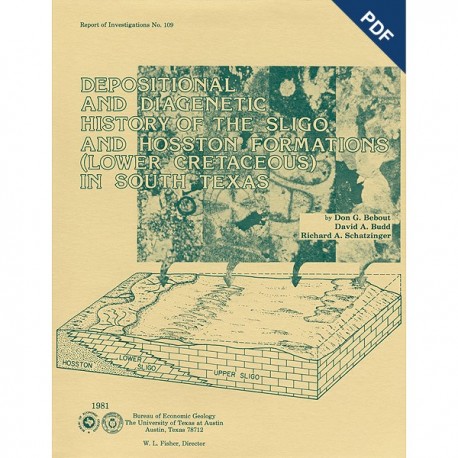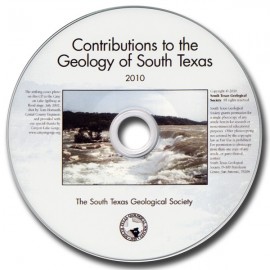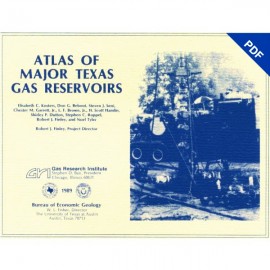Reports of Investigations
-
Books & Reports
- Reports of Investigations
- Guidebooks
- Udden Series
- Geological Circulars
- Down To Earth
- Atlases of Major Oil and Gas Reservoirs
- Texas Memorial Museum Publications
- Environmental Geologic Atlas of the Texas Coastal Zone
- Mineral Resource Circulars
- Other Reports
- Seminars and Workshops
- Handbooks
- Submerged Lands of Texas
- Symposia
- Annual Reports
- Open File Reports
-
Maps & Cross Sections
- Thematic Maps
- Miscellaneous Maps, Charts & Sections
- Geologic Atlas of Texas
- STATEMAP Project Maps
- Geologic Quadrangle Maps
- Cross Sections
- Highway Geology Map
- Energy and Mineral Resource Maps
- Shoreline Change and Other Posters
- Wilcox Group, East Texas, Geological / Hydrological Folios
- Bouguer Gravity Atlas of Texas
- River Basin Regional Studies
- Featured Maps
- Posters
- Teachers & the Public
-
Geological Society Publications
- Gulf Coast Association of Geological Societies
- Alabama Geological Society
- Austin Geological Society
- Corpus Christi Geological Society
- Houston Geological Society
- Lafayette Geological Society
- Mississippi Geological Society
- New Orleans Geological Society
- South Texas Geological Society
- GCS SEPM Publications
- Historic BEG & UT Series

Depositional and Diagenetic History of the Sligo and Hosston Formations... in South Texas. Digital Download
RI0109D
A free, digital version of this publication can be found on: Texas ScholarWorks
To purchase a print version (if available): RI0109
ABSTRACT
The Sligo and Hosston Formations of Aptian age occur over thousands of square miles in the subsurface of South Texas. These two formations consist of three major coeval parts, Hosston, lower Sligo, and upper Sligo, all three of which were deposited contemporaneously to produce a time-transgressive wedge of sediment. Superimposed on the overall transgressive sequence are numerous progradational cycles composed of shoaling-upward sequences. Thirty facies were deposited in six major environments: (I) alluvial plain, (2) tidal-flat complex, (3) inner-shelf lagoon, (4) oolite-shoal complex, (5) outer-shelf lagoon, and (6) shelf margin. Shelf-margin facies include coral-caprinid wackestone, grainstone, and coralgal boundstone deposited in organic banks and associated sand shoals. Back-reef facies are dominated by oyster, toucasid, and miliolid wackestones and oncolite packstones, all deposited in low- to moderate-energy settings. The inner- and outer-shelf facies are low-energy, highly burrowed, skeletal wackestones. Oolite and skeletal grainstones deposited in mobile sand shoals and coated-grain and pellet packstones deposited in stabilized grain flats compose the oolite-shoal complex.
In the Hosston tidal-flat complex, laminated sandstone, dolomite mudstone, and anhydrite were deposited on a broad sabkha. The lower Sligo tidal-flat complex, however, is characterized by abundant subtidal and intertidal deposits, including burrowed dolomite mudstone and pellet-mollusk dolomite wackestone. Supratidal facies in the lower Sligo Formation include not only laminated dolomite mudstone but also skeletal and pellet grainstones deposited as beach ridges and channel levees.
Four stages of diagenesis are apparent in Sligo and Hosston rocks: submarine, early meteoric-phreatic, late meteoric-phreatic, and deep subsurface. The significance of each of these stages to the diagenetic histories of the oolite-shoal complex, inner- and outer-shelf deposits, and shelf-margin complex varies considerably, however. Except at the shelf margin, submarine diagenesis was minimal, consisting primarily of micrite rim formation, deposition of internal sediment, and grain breakage. At the shelf margin, isopachous aragonite cement was precipitated in some of the grainstone facies. Some less widespread Mg-calcite submarine cement also formed. Two ubiquitous early meteoric-phreatic events were the dissolution of aragonite allochems and the precipitation of syntaxial overgrowths on echinoderms. Excellent preservation of original oolite structure suggests that their original mineralogy was Mg-calcite and that therefore the oolites did not undergo dissolution. Rocks of the oolite-shoal complex and adjacent subtidal shelf deposits show evidence of meteoric-phreatic diagenesis, including precipitation of finely crystalline isopachous calcite, compaction and collapse of micrite rims, presence of more isopachous calcite, and mixing-zone dolomitization. Dolomitization is most pronounced in the skeletal and pelletal wackestone facies.
Meteoric-phreatic diagenesis is also significant in the shelf-margin facies. An isopachous, fine-crystalline, equant calcite precipitated only where marine cements were lacking. Pore-filling fine-crystalline calcite spar is limited to skeletal molds; the dominant feature is bladed radiaxial cement. Some of this cement is the product of the inversion of aragonitic submarine cement and rudist shells; however, much appears to have been primary pore-filling cement.
A coarsely crystalline, equant calcite spar was precipitated throughout the Sligo Formation as a late meteoric-phreatic product. This is the final diagenetic product in the shelf-margin facies. However, in the oolite-shoal complex and adjacent subtidal shelf deposits, dolomitization (yielding successively larger rhombs), replacement by anhydrite, cementation by pore-filling baroque dolomite, anhydrite, and euhedral calcite, and formation of authigenic quartz all occur as deep subsurface (below 610 m [2,000 ft]) diagenetic products. The diagenetic history revealed in the dolomitic tidal-flat facies resembles the diagenetic sequences documented for the oolite-shoal complex. Complete dolomitization of all units to a fine- to medium-crystalline, inclusion-rich dolomite in the tidal-flat facies is the only difference.
Significant hydrocarbon production from the Sligo Formation in South Texas is restricted to three gas fields. Two reservoirs are in shelf-margin facies and the other is in shelf-platform facies. In addition, four inactive gas fields occur in the area.
Keywords: depositional history, diagenesis, Hosston Formation, Sligo Formation, South Texas, Cretaceous, facies, Texas
Citation
Bebout, D. G., Budd, D. A., and Schatzinger, R. A., 1981, Depositional and Diagenetic History of the Sligo and Hosston Formations (Lower Cretaceous) in South Texas: The University of Texas at Austin, Bureau of Economic Geology, Report of Investigations No. 109, 69 p.



